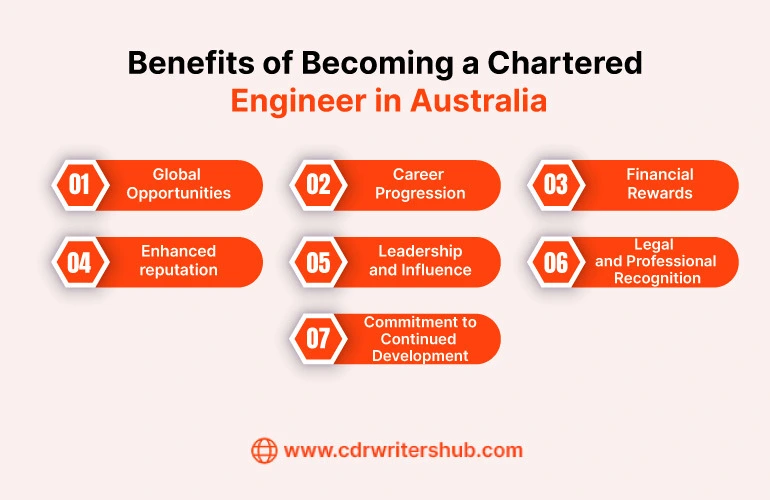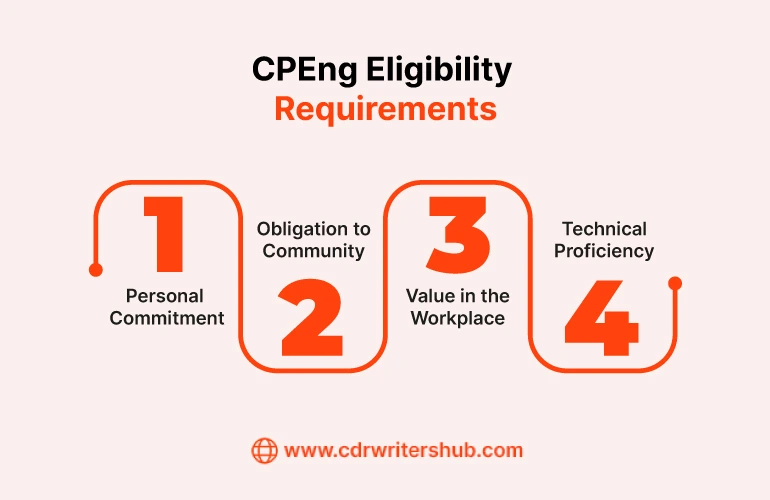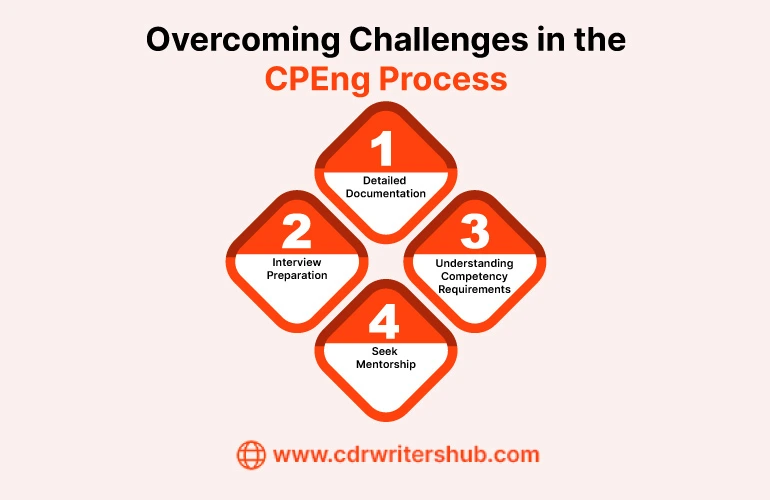Chartered Professional Engineers (CPEng) Australia

Chartered Professional Engineers (CPEng) Australia
Becoming a Chartered Professional Engineer (CPEng) in Australia is an honor that signifies your commitment and skill in engineering, credibility, employability, and earning potential. This globally respected qualification can lead to exciting opportunities, including foreign travel, leadership roles, and career progression.
Engineering is the backbone of modern society, powering our technology and infrastructure. For aspiring engineers, becoming a CPEng in Australia is a major milestone. This internationally recognized credential can unlock doors to leadership positions, career advancement, and high-impact projects.
This article will guide you through the process of becoming a Chartered Professional Engineer in Australia, covering benefits, eligibility requirements, the application process, and the potential advantages of this certification.
What is a Chartered Professional Engineer (CPEng)?
Table of Contents
A Chartered Professional Engineer (CPEng) is an engineer who has demonstrated exceptional competence, professionalism, and ethics in their field.
The Chartered Professional Engineer (CPEng) title is a mark of excellence in engineering, demonstrating that an engineer has achieved a high level of expertise, ethical integrity, and commitment to the profession.
Chartered status is widely acknowledged as a standard of quality and trustworthiness in the field. This prestigious title, awarded by Engineers Australia (EA), signifies an engineer’s commitment to industry standards and continuous professional development (CPD).
Recognized internationally, the CPEng credential is highly valued in Australia and many other countries that prioritize engineering excellence.
Core attributes of a Chartered Engineer:
- Professional Expertise
CPEng engineers have advanced technical skills and the ability to manage complex engineering tasks.
- Ethical Commitment
Chartered engineers are dedicated to ethical practices that protect the public interest and promote sustainability.
- International Credibility
CPEng status is recognized worldwide, making it easier for engineers to pursue international opportunities.
Benefits of Becoming a Chartered Engineer in Australia

Achieving CPEng status provides significant advantages, both professionally and personally. Chartered engineers often enjoy increased career options, higher salaries, and the chance to take on leadership roles within their organizations.
- Global Opportunities
The CPEng credential is your passport to international opportunities. Recognized in countries like the UK, Canada, and the USA, it opens doors to global projects and career advancement.
- Career Progression
Many engineering roles, especially those in leadership, favor or need candidates to hold CPEng certification. CPEng helps to level up your career. Many employers seek Chartered engineers for senior roles, recognizing their expertise and leadership potential.
- Financial Rewards
Chartered engineers are often in higher demand, which translates to increased earning potential. Command higher earnings with a CPEng. Employers value the quality and expertise associated with this prestigious title.
- Enhanced reputation
Elevate your professional reputation. The CPEng credential signifies excellence and builds trust with employers, clients, and colleagues.
- Leadership and Influence
Shape the future of engineering. Chartered engineers often lead teams, mentor others, and influence industry decisions.
-
Legal and Professional Recognition
In some states and sectors, CPEng status is necessary to fulfill specific project or industry requirements.
-
Commitment to Continued Development
Engineers Australia mandates that CPEng holders maintain continuous professional development, ensuring that chartered engineers are always up-to-date with industry advancements.
CPEng Eligibility Requirements

To become a Chartered Professional Engineer (CPEng), you must be a member of Engineers Australia and have at least five years of engineering experience. You’ll need to demonstrate your competence in 16 key areas, categorized into four main groups:
- Personal Commitment
Your dedication to ethical principles and professional standards.
- Obligation to Community
Your contribution to the engineering profession and society.
- Value in the Workplace
Your ability to add value to your organization.
- Technical Proficiency
Your engineering knowledge and skills.
If you have significant experience, you may be eligible for a simplified application process. Additionally, if you hold a foreign Chartered credential from a recognized country, you can apply provided you have completed at least 150 hours of Continuing Professional Development (CPD) in the past three years.
To qualify for CPEng status, engineers must also meet specific educational and professional criteria and show competencies across a range of areas that are listed below:
- Accredited Engineering Qualification
Engineers need a recognized engineering degree or equal qualification to meet the education standards accredited by Engineers Australia.
- Relevant Work Experience
Typically, a least five years of engineering experience is required, showcasing the engineer’s growth and capabilities in their field and demonstrating their ability to manage projects, solve problems, and apply engineering knowledge.
- Competency Evidence
Engineers Australia evaluates applicants on competency across several areas, such as technical expertise, ethical responsibility, and commitment to societal impact.
- Demonstrate Competencies: Prove your proficiency in 16 key areas, including technical expertise, risk management, leadership, communication, and ethics.
- Engage in CPD: Actively participate in Continuing Professional Development (CPD) to stay updated with industry trends and best practices.
To become a Chartered Professional Engineer (CPEng), you need to provide evidence of your commitment, expertise, and experience. Engineers Australia guides members through this process, helping them achieve this globally recognized credential.
By fulfilling the above-listed requirements and providing evidence of your competence and commitment to professional development, you can achieve the prestigious CPEng designation, which validates your engineering expertise and opens doors to global career opportunities.
Key Competency Standards for CPEng Status
Engineers applying for CPEng certification must show competencies across several core areas, which reflect their abilities, values, and professional contributions.
- Technical Skill
Mastery of engineering principles and ability to apply them to complex challenges.
- Personal Integrity
Commitment to ethical conduct, honesty, and professional accountability.
- Professional Impact
Ability to bring value to workplaces through innovative solutions and skilled engineering practices.
- Community and Environmental Responsibility
Consideration for societal welfare and environmental impact in all engineering decisions.
- Professional Development Commitment
Ongoing learning and adaptation to stay current in the ever-evolving engineering field.
The Path to Chartered Engineer
To become a Chartered Engineer, Engineers Australia members follow a six-step process:
- Self-Assessment
- Evaluate your skills and knowledge against Engineers Australia’s Chartered competencies.
- Rate yourself on a scale from developing to advanced.
- Consult the Engineers Australia website for detailed competency standards.
- Industry Review
- Gather feedback on your competencies from industry peers.
- If rated “functional,” proceed to the next step.
- If rated “developing,” seek feedback and improve your skills.
- Enrolling in the Chartered Program
- Pay the required fee.
- Submit your resume, CPD log, industry review, and areas of expertise.
- Providing Evidence
- Submit proof for the 16 competencies.
- Follow Engineers Australia’s guidelines for acceptable evidence.
- Discuss any evidence-related questions with Engineers Australia.
- Professional Consultation
- Attend a one-hour interview with a representative from Engineers Australia and external engineers.
- Present and discuss your submitted evidence.
- Certification
- Receive notification of the outcome via email.
- Successful candidates receive the Chartered Award and certification.
- Unsuccessful candidates receive feedback and guidance for improvement.
Pathways to Chartered Status with Engineers Australia
There are many ways to achieve chartered status, depending on an engineer’s career stage, experience level, and work environment. Engineers Australia offers several pathways to accommodate various backgrounds and career aspirations.
- Professional Development Program (PDP)
This structured pathway, often supported by an employer, guides engineers through a step-by-step process to develop the required competencies.
- Engineering Competency Report (ECR)
The ECR pathway is a self-directed option for those who prefer to independently document their experience and competencies.
- Mutual Recognition Agreements (MRA)
Engineers with chartered status from specific countries can apply for CPEng through recognition arrangements, simplifying the process for internationally qualified engineers.
Step-by-Step Application Process for CPEng

The application process for CPEng status involves several stages to verify an engineer’s skills, experience, and commitment to the profession.
Step 1: Choose Your Pathway
Select the pathway that aligns with your current employment situation and professional goals.
Step 2: Gather Necessary Documentation
Compile academic qualifications, work experience, and references to support your application.
Step 3: Submit a Competency Report
Outline your engineering experience and highlight how your work aligns with the required competencies.
Step 4: Attend an Interview
Engineers Australia conducts an interview to assess technical knowledge and professional integrity.
Step 5: Await the Assessment Outcome
After a thorough review, Engineers Australia will inform you of the assessment decision, which may include feedback for further development if necessary.
The Path to Chartered Engineer and Beyond
- Achieving Chartered Status and Joining the NER
Becoming a Chartered Professional Engineer (CPEng) is a significant milestone for engineers, recognizing their expertise and commitment to the profession.
Many Chartered engineers also choose to join the National Engineering Register (NER), a public database that verifies their competence and ethical standards.
- Maintaining Your Chartered Status
To retain your CPEng status, you must continually engage in professional development. Engineers Australia requires Chartered engineers to complete at least 150 hours of CPD every three years.
This ensures you stay updated with industry trends and maintain high-quality standards.
Alternative Paths to Chartered Engineer
While the standard route to Chartered status is well-defined, there are alternative pathways for engineers with specific qualifications and experience:
- Mutual Recognition Agreements (MRA)
If you hold a Chartered credential from a recognized country, you may be able to transfer your status to Australia.
- Academic Route
Academics in accredited universities may qualify for Chartered status based on their research, teaching, and innovation.
- Naval Charge
Engineers in the Australian Defence Force involved in naval projects may have a streamlined application process.
- Recognized Credentials
Engineers with specific certifications from organizations like INCOSE, AACEI, and AMC may be eligible for direct Chartered status.
Some of the accepted credentials include:
- INCOSE CSEP or ESEP for systems engineering
- AACEI CCP, PSP, EVP, or DRMP for cost engineering
- AMC CSAM or CFAM for asset management
These credentials are accepted as evidence of proficiency in particular engineering domains. To find out how to convert one of these certificates to CPEng status—which is highly respected in the industry—get in touch with Engineers Australia.
CPEng vs. NER: Which is Right for You?
1) CPEng
Recognizes your technical expertise, leadership, and ethical commitment. It’s highly valued by employers and opens doors to international opportunities.
- Expertise Recognition: CPEng signifies an engineer’s proficiency and expertise in their area of specialization.
- Beyond technical proficiency: It reflects leadership qualities, ethical standards, and a commitment to ongoing learning.
- Career Growth: Many senior engineering roles in both the public and private sectors require CPEng status.
- International Reach: This credential is globally recognized, providing access to international career opportunities.
2) NER
Verifies your competence and ethical standards, making it easier for clients and employers to recognize your qualifications.
- Public Qualification Record: NER is a public listing that verifies engineers who meet certain professional standards.
- Enhanced Credibility: While not as prestigious as CPEng, NER registration can still strengthen an engineer’s reputation.
- Regulatory Compliance: NER is often required for engineers in regulated fields, supporting public safety standards.
While both qualifications are valuable, the CPEng designation generally offers more significant career benefits. However, NER registration can be beneficial for engineers working in regulated sectors.
Choosing Your Path
- Long-Term Goals: For those seeking leadership and international roles, CPEng is generally the best choice.
- Local Compliance: For engineers focused on local projects and regulatory requirements, NER registration may be sufficient.
- Broader Career Options: Many engineers pursue both CPEng and NER to expand their professional opportunities.
Costs Associated with Becoming a Chartered Engineer
Becoming a Chartered Engineer involves various fees, including:
- Initial Application Fee
This fee covers the self-assessment, industry review, and evidence submission processes. The exact amount varies based on your specific field and Engineers Australia membership status.
- Professional Consultation Fee
Once your evidence is reviewed, you may be required to attend a consultation interview with Chartered engineers. A fee may be associated with this process.
- Ongoing CPD Costs
Maintaining your Chartered status necessitates continuous professional development. This includes expenses for attending workshops, conferences, training programs, and other learning activities.
- Annual Membership Fees
To retain your Chartered status and enjoy the benefits of Engineers Australia membership, you’ll need to pay annual membership fees.
These fees cover access to resources, networking opportunities, and discounts on professional development programs.
Overcoming Challenges in the CPEng Process

The journey to obtaining CPEng status can be demanding, with rigorous documentation and assessment requirements. To increase your chances of a successful application, take a strategic approach to show your capabilities and experience.
Here are some challenges and the ways to overcome them.
- Detailed Documentation
Ensure all qualifications, work experiences, and competencies are well documented and verified.
- Interview Preparation
Thoroughly prepare for the interview by reviewing Engineers Australia’s competency framework and practicing responses.
- Understanding Competency Requirements
Align your documented experience closely with each competency standard to avoid gaps in your application.
- Seek Mentorship
Consulting a current Chartered Engineer can provide insights and help you refine your application.
Life as a Chartered Professional Engineer: Ongoing Responsibilities
Once you’ve achieved CPEng status, maintaining it requires continuous professional development and adherence to Engineers Australia’s standards.
- Professional Development
Engineers are required to complete CPD hours each year, which keep their skills and knowledge up-to-date.
- Periodic Competency Reviews
Engineers Australia may need re-certification to ensure continuous competency and alignment with industry advancements.
Conclusion
Achieving CPEng status as a Chartered Professional Engineer in Australia is a highly respected career milestone. This title, granted by Engineers Australia, signifies a commitment to excellence, ethics, and ongoing professional growth.
By understanding the eligibility requirements, application process, and benefits of CPEng, engineers can confidently pursue chartered status and unlock many career opportunities in Australia and around the world.
While the path to becoming chartered is challenging, the benefits make it worthwhile. The CPEng credential reflects your dedication to top-tier engineering standards, offering advantages like global mobility and increased earning potential.
Engineers Australia offers a structured and supportive process for those ready to take the next step in their engineering careers in Australia.
FAQs
1) How can I become a chartered engineer? What are the eligibility criteria?
Here are the requirements to become a Chartered Engineer (CPEng) in Australia:
Qualifications
- A valid engineering degree is required for education.
- Professional Experience: Five years or more of experience in a related field.
- Competency demonstration: Engineers Australia evaluated evidence of technical skill, moral dedication, social responsibility, and professional development.
Ways to Become Chartered
- Program for Professional Development (PDP): An organized, employer-sponsored route.
- A self-directed way to record your competencies is with an Engineering Competency Report (ECR).
- For engineers with chartered status in nations with mutual recognition agreements, there are mutual recognition agreements (MRAs).
Chartered status, which opens up more advanced career options and professional recognition, is the end goal of each track.
2) How do graduates of the CSE program become chartered engineers?
In India, a chartered engineer is essentially a qualified engineer who has also been accredited as such by the Institute of Engineers (India).
Applications for registration as chartered engineers can be submitted to the Institute of Engineers by trained engineers who hold a position of responsibility in the specific area. They can provide you with the specifics.
3) Key Differences Between IES and ESE for Engineers in India
- Purpose
IES (Indian Engineering Services) is focused on recruiting engineers specifically for government engineering roles.
ESE (Engineering Services Examination) is a broader exam that allows engineers from all disciplines to join various government departments.
- Competitiveness
IES is highly competitive with limited seats, offering prestigious, specialized roles.
ESE is less specialized than IES and generally admits a larger number of candidates.
- Eligibility
IES is only for Indian citizens.
ESE is open to both Indian citizens and certain international candidates.
- Exam Structure
Both exams have two parts: preliminary (aim) and main (subjective), plus an interview. However, IES exams tend to focus more on specialized engineering subjects.
- Career Scope
IES officers receive job security and growth opportunities and work in sectors like transportation, power, and public works with government positions.
4) What distinguishes a chartered engineer, a professional engineer, and a simple engineer?
Chartered Engineer” and “Professional Engineer” mean different things in different countries
United Kingdom: A Chartered Engineer (CEng) is a registered member of the Engineering Council who demonstrates advanced professional competencies by holding a master’s degree or similar experience.
The United States: A Professional Engineer (PE) is qualified to sign and seal engineering designs, particularly in civil engineering or consulting, after completing four years of coursework, gaining four years of experience, and passing two tests.
Unless they provide public consulting services, the majority of engineers hold four-year degrees and operate directly in industry without requiring these qualifications.
5) How much does the CPEng application cost?
Although the price varies, Engineers Australia charges an annual membership fee besides an application fee. The website of Engineers Australia provides information on the precise costs, which are contingent upon membership status.
6) How long does it take to complete the CPEng process?
Depending on the pathway selected, the applicant’s level of preparedness, and the amount of time Engineers Australia needs to assess the application, the CPEng process normally takes several months.
7) Is CPEng status required for all engineering roles in Australia?
Although it is frequently recommended for senior positions and might be crucial for roles with significant responsibility, public safety, or regulatory compliance, CPEng is not necessary for all roles.
8) Can international experience count toward CPEng eligibility?
Yes, as long as it satisfies Engineers Australia’s competency criteria and regulations, relevant international engineering experience can count toward CPEng eligibility.



